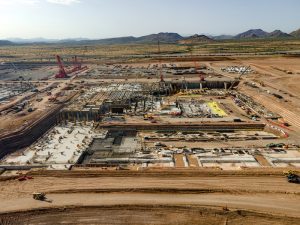Oil has held a prominent spot in the news cycle of late as barrel prices reach a two-year high. The culprit: political arrests in Saudi Arabia, the world’s second-largest oil producer.
It’s an important sector of the energy field for a business journalist, and chances are your editor will expect you to cover it as part of your reporting. You say you don’t actually know much about the oil world? Here’s a handy crash course that will give you the gist of the industry without causing too much stress.
Consumption
Crude oil and other fossil fuel-based liquids are refined into petroleum products. In 2016, the United States consumed 7.21 billion barrels of petroleum products, averaging about 19.69 million barrels per day, according to the U.S. Energy Information Administration.
States that were the biggest oil gluttons in 2016? California, Texas, Florida, New York and Georgia.
On the international stage, 93 million barrels were consumed per day in 2015, according to EIA. The U.S. used 20.5 percent of that, making it the world’s largest oil consumer followed by China (12.6 percent). Japan and India tied for third, both grabbing 4.3 percent.
Production and price
Members of Organization of the Petroleum Exporting Countries, or OPEC, produce 40 percent of the global oil supply, according to the New York Times. There are currently 14 member countries, including Saudi Arabia, Iraq and Venezuela.
There is currently an oil glut in the market, meaning there is far more supply than there is demand. So although prices are currently high, temporarily hanging around the upper-$50s to lower-$60s, they are manufactured by political tensions. Experts expect prices to drop back down, and project that 2018 prices will be in the low- to mid-$50s a barrel.
Note that oil prices were below $30 in early 2016, significantly lower than the $90-$100 norm before the late 2014 crash.
The only true way to increase prices is to create a deficit: More demand than supply could normalize the market, Colorado-based Drillinginfo analyst Sarp Ozkan told me for the Denver Post. But decreasing the excess oil in the market is easier said than done.
The agreement between OPEC, Russia and other suppliers to put a cap on production currently expires in March 2018. But Saudi Arabia, Iraq and other major oil exporters are expected to push for an extension in a Nov. 30 meeting. (Analysts expect the current high prices to temporarily stick around as investors watch for that meeting.)
However, those caps haven’t been enough to cause much change yet in the cost per barrel. Additionally, American and Libyan oil producers have not slowed production and continue to flood the market with more oil than current demand. Oh, and Americans didn’t partake in enough cross-country road trips this summer, missing the chance to gobble up some of that oil.
Other quick oil facts
• At least 123 North American oil companies filed for bankruptcy since early 2015, according to the New York Times. More than 150,000 oil workers lost their jobs.
• Some surviving companies, such as Exxon Mobil, have shown an interest in renewable alternatives.
• As the U.S. dollar strengthens, oil per barrel prices drop.
• The number of operating rigs in the U.S. went down at the start of November, according to Baker Hughes, which monitors drilling activity. There are currently 898 rigs operating.










